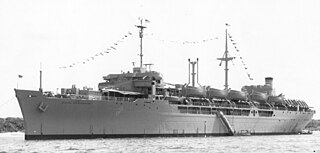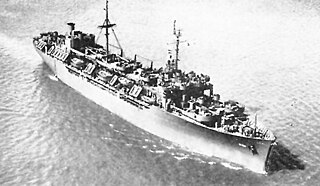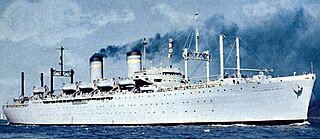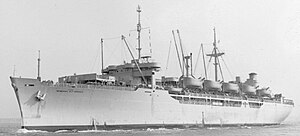
USS Admiral W. S. Sims (AP-127) was a transport in the United States Navy. She was later renamed USNS General William O. Darby (T-AP-127). Later her name was struck and she was known simply by her hull number. In 1981, she was reclassified as IX-510.

USS Admiral Hugh Rodman (AP-126) was an Admiral W. S. Benson-class transport: Laid down, 24 April 1944, as a Maritime Commission type (P2-SE2-R1) hull, under Maritime Commission contract,, at Bethlehem Shipbuilding Corporation, Alameda, California; launched on 25 February 1945; commissioned as the USS Admiral Hugh Rodman (AP-126), 7 July 1945, decommissioned on 14 May 1946, at New York; transferred to the U.S. Army Transportation Service in May 1946; commissioned USAT General Maurice Rose on 1 August 1946; reacquired by the U.S. Navy and assigned to the Military Sea Transport Service (MSTS); placed in service as USNS General Maurice Rose (T-AP-126) on 1 March 1950.

USS General George M. Randall (AP-115) was a General John Pope class troop transport which served with the United States Navy in World War II and the postwar era. She was named after Major General George Morton Randall, an American Civil War hero, and veteran of the Indian wars of the 1880s and the Philippines in the early 1900s.

USS General Stuart Heintzelman (AP-159) was a General G. O. Squier-class transport ship for the U.S. Navy in World War II. She was named in honor of U.S. Army general Stuart Heintzelman. She was transferred to the U.S. Army as USAT General Stuart Heintzelman in 1946. On 1 March 1950 she was transferred to the Military Sea Transportation Service (MSTS) as USNS General Stuart Heintzelman (T-AP-159). She was later sold for commercial operation before being scrapped in 1984.

USS General W. G. Haan (AP-158) was a General G. O. Squier-class transport ship for the US Navy in World War II. She was named in honor of US Army Major General William G. Haan. She was transferred to the US Army as USAT General W. G. Haan in 1946. On 1 March 1950, she was transferred to the Military Sea Transportation Service (MSTS) as USNS General W. G. Haan (T-AP-158). She was later sold for commercial operation under several names before being scrapped in 1987.

USS General C. C. Ballou (AP-157) was a General G. O. Squier-class transport ship for the U.S. Navy in World War II. She was named in honor of U.S. Army general Charles Clarendon Ballou. She was transferred to the U.S. Army as USAT General C. C. Ballou in 1946. On 1 March 1950, she was transferred to the Military Sea Transportation Service (MSTS) as USNS General C. C. Ballou (T-AP-157). She was later sold for commercial operation under several names before being scrapped some time after 1981.

USS General D. E. Aultman (AP-156) was a General G. O. Squier-class transport ship for the U.S. Navy in World War II. The ship was crewed by the U.S. Coast Guard throughout the war. She was named in honor of U.S. Army general Dwight Edward Aultman. She was transferred to the U.S. Army as USAT General D. E. Aultman in 1946. On 1 March 1950 she was transferred to the Military Sea Transportation Service (MSTS) as USNS General D. E. Aultman (T-AP-156). She was later sold for commercial operation under the name SS Portland, before being scrapped some time after October 1986.

USS General A. W. Brewster (AP-155) was a General G. O. Squier-class transport ship for the U.S. Navy in World War II. The ship was crewed by the U.S. Coast Guard throughout the war. She was named in honor of U.S. Army general Andre Walker Brewster. She was transferred to the U.S. Army as USAT General A. W. Brewster in 1946. On 1 March 1950 she was transferred to the Military Sea Transportation Service (MSTS) as USNS General A. W. Brewster (T-AP-155). She was later sold for commercial operation under the name SS Philadelphia, before being scrapped some time after November 1987.

USS General R. M. Blatchford (AP-153) was a General G. O. Squier-class transport ship for the U.S. Navy in World War II. She was named in honor of U.S. Army general Richard M. Blatchford. She was transferred to the U.S. Army as USAT General R. M. Blatchford in 1946. On 1 March 1950 she was transferred to the Military Sea Transportation Service (MSTS) as USNS General R. M. Blatchford (T-AP-153). She was later sold for commercial operation under the names SS Stonewall Jackson and Alex Stephens, before being scrapped in 1980.

USS General W. M. Black (AP-135) was a General G. O. Squier-class transport ship for the U.S. Navy in World War II. The ship was crewed by the U.S. Coast Guard until decommissioning. She was named in honor of U.S. Army general William Murray Black. She was transferred to the U.S. Army as USAT General W. M. Black in 1946. On 1 March 1950 she was transferred to the Military Sea Transportation Service (MSTS) as USNS General W. M. Black (T-AP-135). She was later sold for commercial operation under the name SS Green Forest, before being scrapped in 1980.

USS General M. B. Stewart (AP-140) was a General G. O. Squier-class transport ship for the U.S. Navy in World War II. She was named in honor of U.S. Army general Merch Bradt Stewart. She was transferred to the U.S. Army as USAT General M. B. Stewart in 1946. On 1 March 1950 she was transferred to the Military Sea Transportation Service (MSTS) as USNS General M. B. Stewart (T-AP-140). She was later sold for commercial operation under the name SS Albany, before being scrapped in July 1987.

USS General C. H. Muir (AP-142) was a General G. O. Squier-class transport ship for the U.S. Navy in World War II. The ship was crewed by the U.S. Coast Guard until decommissioning. She was named in honor of U.S. Army general Charles Henry Muir. She was transferred to the U.S. Army as USAT General C. H. Muir in 1946. On 1 March 1950 she was transferred to the Military Sea Transportation Service (MSTS) as USNS General C. H. Muir (T-AP-142). She was later sold for commercial operation under the names SS Chicago and SS San Juan, and was scrapped some time after 1985.

USS General H. B. Freeman (AP-143) was a General G. O. Squier-class transport ship for the U.S. Navy in World War II. The ship was crewed by the U.S. Coast Guard until decommissioning. She was named in honor of U.S. Army general Henry Blanchard Freeman. She was transferred to the U.S. Army as USAT General H. B. Freeman in 1946. On 1 March 1950 she was transferred to the Military Sea Transportation Service (MSTS) as USNS General H. B. Freeman (T-AP-143). She was sold for commercial operation in 1965, and eventually scrapped.

USS General W. F. Hase (AP-146) was a General G. O. Squier-class transport ship for the US Navy in World War II. She was named in honor of US Army Major General William Frederick Hase. She was transferred to the US Army as USAT General W. F. Hase in 1946. On 1 March 1950 she was transferred to the Military Sea Transportation Service (MSTS) as USNS General W. F. Hase (T-AP-146). She was later sold for commercial operation in 1968, before being scrapped in 1985.

USS General M. M. Patrick (AP-150) was a General G. O. Squier-class transport ship built for the US Navy in World War II. She was named in honor of US Army general Mason Mathews Patrick, a graduate of the US Military Academy in 1886. Promoted to major general in 1918, during World War I, he was appointed Chief of the Army Air Service, the position he held until his retirement in 1927. After the Armistice, he represented the A.E.F. at the Paris Peace Conference.

USS General M. L. Hersey (AP-148) was a General G. O. Squier-class transport ship of the U.S. Navy in World War II. She was named in honor of U.S. Army general Mark Leslie Hersey. She was transferred to the U.S. Army as USAT General M. L. Hersey in 1946. On 1 March 1950 she was transferred to the Military Sea Transportation Service (MSTS) as USNS General M. L. Hersey (T-AP-148). She was later sold for commercial use, and operated under the names SS Pittsburgh and SS St. Louis.

USS General W. C. Langfitt (AP-151) was a General G. O. Squier-class transport ship for the U.S. Navy in World War II. She was named in honor of U.S. Army general William Campbell Langfitt. She was transferred to the U.S. Army as USAT General W. C. Langfitt in 1946. On 1 March 1950 she was transferred to the Military Sea Transportation Service (MSTS) as USNS General W. C. Langfitt (T-AP-151). She was later sold for commercial operation under the name SS Transindiana, before ultimately being scrapped in 1983.

USS General H. W. Butner (AP-113), named for Henry W. Butner, was a troopship that served with the United States Navy in World War II and the Korean War. She was redesignated T-AP-113 in October 1949.

USS General W. H. Gordon (AP-117) was a troop transport that served with the United States Navy in World War II. After the war, she was transferred to the US Army and served as USAT General W. H. Gordon. In the mid to late 1940s she sailed in trans-Pacific American President Lines passenger service with sister ship SS General Meigs. With the outbreak of the Korean War, she was reacquired by the Navy as a civilian-crewed Military Sea Transportation Service (MSTS) vessel, and redesignated USNS General W. H. Gordon (T-AP-117). She served again under the same designation in the Vietnam War.

USS Admiral R. E. Coontz (AP-122) was an Admiral W. S. Benson-class transport built for the U.S. Navy during World War II. She was laid down under a Maritime Commission contract on 15 January 1943 at Alameda, California, by the Bethlehem Steel Corp., and launched on 22 April 1944. She was sponsored by Mrs. Edwin Kokko, daughter of Admiral Coontz, and commissioned on 21 November 1944.




















